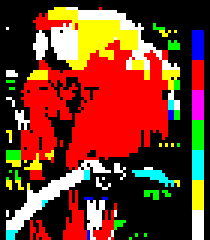
The Acorn Electron was a lower-cost alternative to the BBC Micro educational/home computer, also developed by Acorn Computers Ltd, to provide many of the features of that more expensive machine at a price more competitive with that of the ZX Spectrum. It had 32 kilobytes of RAM, and its ROM included BBC BASIC II together with the operating system. Announced in 1982 for a possible release the same year, it was eventually introduced on 25 August 1983 priced at £199.

Viewdata is a Videotex implementation. It is a type of information retrieval service in which a subscriber can access a remote database via a common carrier channel, request data and receive requested data on a video display over a separate channel. Samuel Fedida, who had the idea for Viewdata in 1968, was credited as inventor of the system which was developed while working for the British Post Office which was the operator of the national telephone system. The first prototype became operational in 1974. The access, request and reception are usually via common carrier broadcast channels. This is in contrast with teletext.

Videotex was one of the earliest implementations of an end-user information system. From the late 1970s to early 2010s, it was used to deliver information to a user in computer-like format, typically to be displayed on a television or a dumb terminal.
Bit blit is a data operation commonly used in computer graphics in which several bitmaps are combined into one using a boolean function.

Mullard Limited was a British manufacturer of electronic components. The Mullard Radio Valve Co. Ltd. of Southfields, London, was founded in 1920 by Captain Stanley R. Mullard, who had previously designed thermionic valves for the Admiralty before becoming managing director of the Z Electric Lamp Co. The company soon moved to Hammersmith, London and then in 1923 to Balham, London. The head office in later years was Mullard House at 1–19 Torrington Place, Bloomsbury, now part of University College London.
Text mode is a computer display mode in which content is internally represented on a computer screen in terms of characters rather than individual pixels. Typically, the screen consists of a uniform rectangular grid of character cells, each of which contains one of the characters of a character set; at the same time, contrasted to all points addressable (APA) mode or other kinds of computer graphics modes.

The Philips P2000T home computer was Philips' first real entry in the home computer market in 1980, after the Philips Videopac G7000 game system which they already sold to compete with the Atari 2600 and similar game systems. There was also a P2000M version with an additional 80-column text card for use with a monochrome monitor. This version shipped with a monitor cabinet also housing a dual 5.25" floppy drive. The P2000C version, introduced in 1982, was portable.
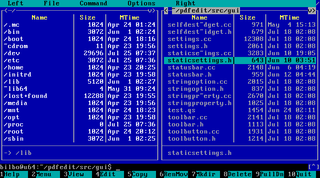
Box-drawing characters, also known as line-drawing characters, are a form of semigraphics widely used in text user interfaces to draw various geometric frames and boxes. These characters are characterised by being designed to be connected horizontally and/or vertically with adjacent characters, which requires proper alignment. Box-drawing characters therefore typically only work well with monospaced fonts. In graphical user interfaces, these characters are much less useful as it is more simple and appropriate to draw lines and rectangles directly with graphical APIs. However, they are still useful for command-line interfaces and plaintext comments within source code.
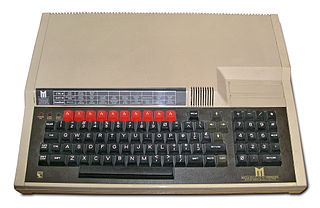
The BBC Master is a home computer released by Acorn Computers in early 1986. It was designed and built for the British Broadcasting Corporation (BBC) and was the successor to the BBC Micro Model B. The Master 128 remained in production until 1993.

Teletext, or broadcast teletext, is a standard for displaying text and rudimentary graphics on suitably equipped television sets. Teletext sends data in the broadcast signal, hidden in the invisible vertical blanking interval area at the top and bottom of the screen. The teletext decoder in the television buffers this information as a series of "pages", each given a number. The user can display chosen pages using their remote control. In broad terms, it can be considered as Videotex, a system for the delivery of information to a user in a computer-like format, typically displayed on a television or a dumb terminal, but that designation is usually reserved for systems that provide bi-directional communication, such as Prestel or Minitel.

A video display controller or VDC is an integrated circuit which is the main component in a video-signal generator, a device responsible for the production of a TV video signal in a computing or game system. Some VDCs also generate an audio signal, but that is not their main function.

World System Teletext (WST) is the name of a standard for encoding and displaying teletext information, which is used as the standard for teletext throughout Europe today. It was adopted into the international standard CCIR 653 of 1986 as CCIR Teletext System B.
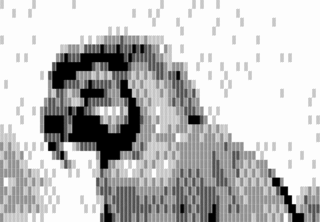
Text-based semigraphics, pseudographics, or character graphics is a primitive method used in early text mode video hardware to emulate raster graphics without having to implement the logic for such a display mode.
This article covers technical details of the character encoding system defined by ETS 300 706, a standard for World System Teletext, and used for the Viewdata and Teletext variants of Videotex in Europe.
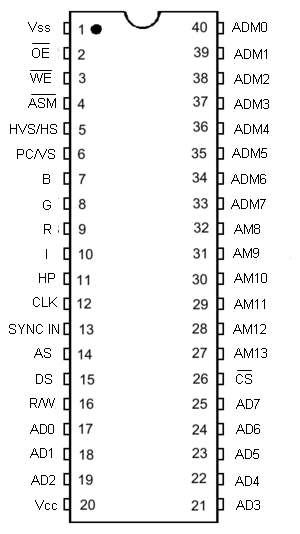
The EF9345 from SGS-Thomson Microelectronics, Inc., was a semigraphic microprocessor for video image control, encapsulated in a 40-pin DIP and used primarily in the Matra Alice 32, Matra Alice 90 and Philips VG5000 microcomputers.
The TEA1002 is a PAL video encoder chip produced by Mullard in 1982 and used on the Mattel Aquarius computer and AlphaTantel Prestel adapter. It was also used on teletext decoders and color bar generators associated with video test equipment.

JTES, the Japanese Teletext Specification, is a protocol used for encoding teletext pages, as well as other types of digital data, within the vertical blanking interval (VBI) of an analog video signal in Japan. It was adopted into the international standard CCIR 653 of 1986 as CCIR Teletext System D.


